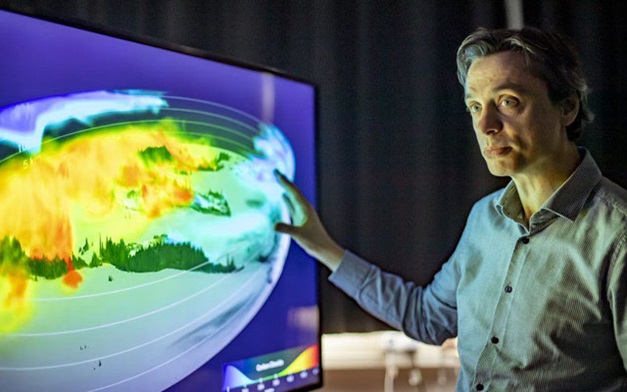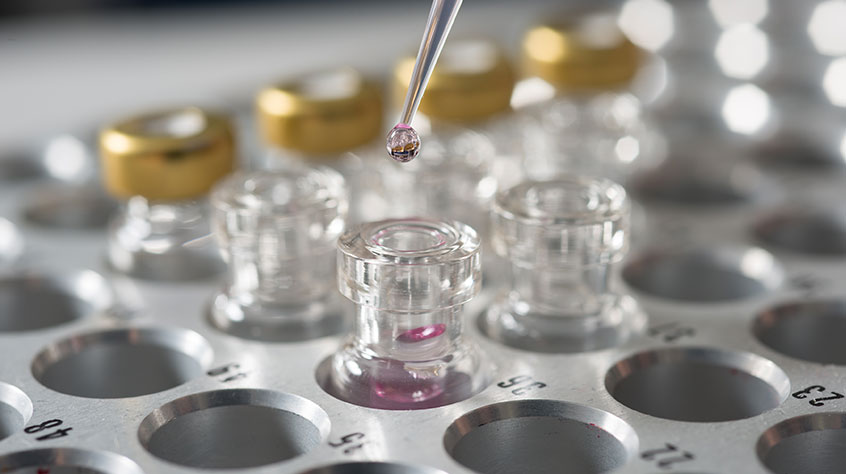Sharp eyes to the skies
 Hartmut Boesch explores how we use satellites to monitor greenhouse gases in the Earth’s atmosphere. Sharp-eyed satellites that orbit the earth provide a global view of where greenhouse gases, including CO2 and Methane, are emitted into the atmosphere and where they are removed from the atmosphere.
Hartmut Boesch explores how we use satellites to monitor greenhouse gases in the Earth’s atmosphere. Sharp-eyed satellites that orbit the earth provide a global view of where greenhouse gases, including CO2 and Methane, are emitted into the atmosphere and where they are removed from the atmosphere.
This is a relatively new approach in addressing the drivers for climate change and identifying emission areas. In the last 10-15 years scientists have been using satellites to provide a unique, global picture that provides an understanding of the greenhouse gas exchange with the surface and how much remains in earth’s atmosphere.
Gases can remain in the atmosphere for long periods of time. For example, CO2 remains in the atmosphere for hundreds of years – so what we do now, will affect generations hundreds of years down the line.
Professor Boesch explains, “Only half of the CO2 that is produced will remain in the atmosphere, the other half will be removed by earth’s vegetation and oceans. This is why it is important to get a detailed understanding of how these natural parts of the world are functioning. Are they going to continue behaving in the same way, or will climate change and human impacts, such as de-forestation, change how they work.
"Most forests and forms of vegetation remove a lot of carbon. Such nature based solutions can make an important contribution, but we can’t plant enough to combat the CO2 emissions.”
Hartmut’s interest in this area of research sparked when he had finished his PhD – he was fascinated by, what was then, the new idea of measuring CO2 from space, satellites giving the true global picture. Before this new development, research was based on greenhouse gas measurements being on the ground – even today this still happens, so provides limited information – using satellites will give that overview that hadn’t been provided until now.
He explains the importance of space technology in combating climate change:

Satellites can give you amazing information about parts of the world without even physically going there. It is very intriguing, getting immediate images, and a true picture of the world and how it is changing for example due to changing climate.
“There’s a permanent development of space tech. One of the areas emerging is that we can start to pin-point particular areas like oil refineries – we can advise on their impact and they can work to address it. Traditional satellites were tailored to observing large areas, but now we can start to see for example ‘super emitters’ for methane – we are discovering new emitters we hadn’t know about before.”
What is the impact of this research?
One of the impacts is that we can now develop the idea that you can build satellites to monitor CO2 emissions and other gases from space. We are now moving towards satellites that help to meet the goals of the Paris Agreement – they underpin it to help policy makers develop policies. This is a big transformation from science to informing government and changing policies.
Hartmut says: “There needs to be an impact on the climate change discussion – the science is here.
To make the transition that we need, we need support from the public and policy makers. It may mean society making difficult decisions – like lifestyle changes. There is a need to make data and information accessible to people.
"For example, if you provide air quality measurements to people, they can see air quality data in their area and they will want to contribute to change. We need to get to that stage for greenhouse gases. There is no reason why CO2 sensors can’t be used as standard by cities but there is currently no system in place to monitor greenhouses gases in cities.
"We are working with cities in developing CO2 monitoring to help cities on the scale of Leicester whether we can see change. We also want to work with the public, schools, churches so that we can get communities to take note and interest and make change.”
What’s the impact on our daily lives?
If the impact of greenhouse gases isn’t taken seriously, what would be the outcome? We’ve already seen reports on icebergs melting/breaking away, or increases in droughts, but what would that mean to our daily lives?
Hartmut explains, “The real issue is that changes are happening quite slowly, so people don’t feel so threatened by them. The difficulty is to react to something that will happen in 20 years. People will see obvious things like snow disappearing – for example winter in the UK has changed. We will see more extreme weather situations. Dry areas will become dryer, wet areas will become wetter. The UK may be less severely impacted than other areas of the world – there will be some areas of the world that will become uninhabitable.
“There are serious questions about securing the futures of food supply – some areas in southern Europe may find it hard to maintain their agriculture industry due to the change in climate.
“There is a need to mitigate this – rich countries will be in a much better position to adapt, there may be engineering solutions, maintaining agricultural activities, whereas developing countries won’t have the capacity to do this. Therefore, it would be dangerous for all countries to think that it isn’t a problem.
“The focus absolutely has to be on solving the root cause.”
Individuals may feel overwhelmed to make small changes as this is such a huge problem. Hartmut explains how society can contribute and that small changes do make a difference:
“COVID has changed the way we live, and it would be a mistake to go back to pre-COVID habits in how we live. For example, flying to another country to have a short meeting, may no longer happen.
“The Paris agreement is such a positive development, and gives hope for optimism – the UK is at the forefront and has agreed to be Net Zero by 2050 – this has been enshrined in law that by 2035 emissions will be down by 78% (compared with 1990 level).
“You can achieve these goals without damaging your economy. It’s future-proofing your economy. It gives great hope, but all countries need to support it, and the support of the population is essential. An ambitious but a great goal, it will focus minds which will lead to ideas and programmes to enable change.”
Recent changes including Electric vehicles, residential heating and housing will make a difference. The UK is already looking intensively at renewables and non-fossil fuels. However, an individual country can only do so much, we need to be working with other countries across the globe.
Hartmut says, “As members of the public, we should ask ourselves if we really need to drive somewhere. There needs to be a bigger investment in public transport to enable this - make cities for people and not cars.”
Looking to the future
There is a big push with the European Space Agency (ESA) in developing a new generation of satellites with mitigation requirements in line with the Paris Agreement – within the next 5 years.
These satellite programmes will provide greenhouse gas monitoring data for many years that you can use to better understand how emission from cities work and if our measures to reduce emissions are working.
When asked what Hartmut sees the future of his research as being, he replies:
“Right now, the holy grail is to really push the boundaries and use satellites with confidence to identify and quantify emissions. It’s not yet fully clear - how do we really tell if CO2 or Methane is from humans and not natural resources?
“The big challenge that we are facing now is telling them apart and how the information that is needed not only by scientists but also by policy makers and the general public can be generated.”





